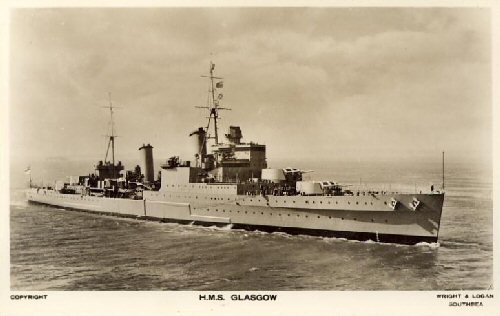
Scrapped 1958
HMS Glasgow, built by Scotts,launched 20/6/1936, Southampton-class light cruiser, a sub-class of the Town-class, commissioned in September 1937. She displaced 11,930 tons with a top speed of 32 knots (59 km/h). She was part of the Home Fleet, and escorted the King and Queen to Canada in 1939. She also took a large quantity of gold to Fort Knox as an emergency reserve.
On 14 April 1940, during the Norweigan Campaign in World War II, HMS Glasgow, along with HMS Sheffield and ten destroyers landed an advance force of Royal Marines at Namos to seize and secure the wharves and approaches to the town, preparatory to the landing of a larger Allied force.
Later in the campaign, she transferred King Haakon VII of Norway and Crown Prince Olav V of Norway and Norwegian gold reserves when they escaped from the German occupation of their country.
Glasgow was then employed as a convoy escort in the Mediterranean Sea and she took part in the Fleet Air Arm raid that crippled the Italian Fleet at Taranto.
In December 1940 she was damaged by torpedoes that put two of her four shafts out of action. This limited her ability to be assigned to missions and it was not until 1942 that she was properly repaired. In 1943 with the cruiser Enterprise , she fought a three-hour battle with eleven enemy destroyers of which three were sunk and four damaged with gunfire.
On D-Day , Glasgow led a US Force toward the beaches, providing naval gunfire support to the landing parties. After the end of the war, she took on Flagship duties of Commander in Chief Fleet East Indies; in 1948 the Flagship of the American and West Indies Station and in 1951 she became the Flagship of the Commander in Chief Mediterranean, Admiral the Earl Mountbatten of Burma. She was broken up in 1958.